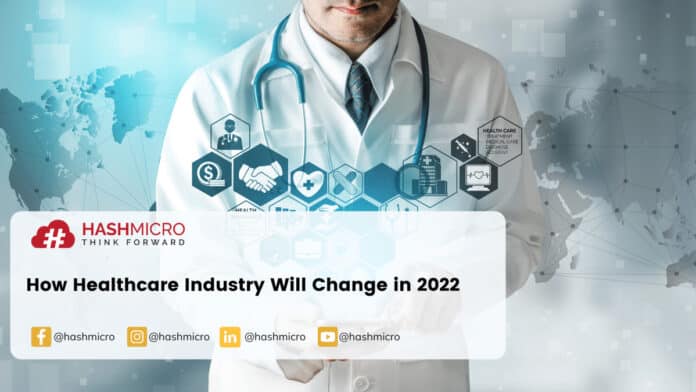In these unprecedented times, what should hospital and healthcare industry boards prioritize in order to prepare for 2024 and beyond? As organizations navigate the pandemic, society anticipates that success will increasingly rely on collaboration, innovation, digitization, and outscoring the competition.
To have an increase in those things, hospitals, and healthcare systems might need the addition of reliable facility management software. With the help of the said facility automation for hospitals and healthcare systems, they will be more than likely to have a change, reach success, and thrive even in this pandemic.
COVID-19 has uncovered vulnerabilities in healthcare organizations around the world, including safety, equipment, data availability, and infrastructure. Early on, it became clear that a company could not rely solely on its own supply lines and capabilities.
Successful organizations will build on this mentality by discovering ways to close gaps and innovate with partners who bring unique problem-solving skills. These are the things that could be aided by a good facility management system.
The ability to close gaps and collaborate brought by the facility software will be able to help the vulnerability in healthcare organizations.
Table of Content:
Table of Content
How Healthcare Changes Throughout the History
Healthcare reform has been frequently proposed but rarely implemented. The first attempt was made in the 20th century by the American Association for Labor Legislation (AALL). In committee, House Speaker Thaddeus Sweet vetoed the bill.
In 1965, after 20 years of congressional debate, President Lyndon B. Johnson signed into law the Great Society Legislation, which included Medicare and Medicaid.
Since 1996, a number of laws, including the Consolidated Omnibus Budget Reconciliation Act (COBRA) and the Health Insurance Portability and Accountability Act (HIPAA), have been enacted to provide health insurance coverage for some former employees. The Patient Protection and Affordable Care Act of 2010, also known as Obamacare, contains:
- The Affordable Health Care for America Act
- The Patient Protection Act
- The healthcare-related sections of the Health Care and Education Reconciliation Act and the Student Aid and Fiscal Responsibility Act
Additional rules and regulations have been added to the Patient Protection and Affordable Care for America Act since it became law.
Also read: 5 Benefits of Booking Software for Medical Equipment Rental Business
How Changes Impact Healthcare Resources and Facilities

Changes in the healthcare industry typically originate at the legislative level, but once enacted, these alterations have a direct effect on facility operations and resource utilization.
For instance, legislation has altered how patients and administrators utilize resources such as Medicare and Medicaid. Technology in the healthcare industry has further influenced how healthcare administrators manage resources and medical centers.
Changes in the past and future of healthcare facilities
In the last century, cultural shifts, care costs, and policy changes have led to greater patient autonomy. Technology advances a patient-centered healthcare system. This trend is expected to continue as wearable biometric devices and GPS tracking are introduced for clinical use. Alongside those technologies, the appearance of facility management software for hospitals is also a hot topic.
Individual facilities’ policies and procedures may restrict the introduction of new technologies, but there is an anticipation that cutting-edge technology will play an increasingly important role in our healthcare system in the coming years.
Especially in the demand for collaboration, one-platform management software for the facility will be needed. Now, the said software has downloadable pricing scheme calculations for the possible client to learn about it.
Medicare and Medicaid
Hospital Insurance and Medical Insurance were included in the 1965 Medicare and Medicaid bill (Medical Insurance). Since then, Congress has expanded Medicare and Medicaid eligibility. Disabled and older people were added to Medicare in 1972.
Medicare now includes unlimited home health visits and nursing home quality standards. Also included are low-income families, pregnant women, people in need of long-term care, and disabled people.
Individual states have the ability to tailor Medicaid programs to meet the needs of their residents, resulting in wide variations in Medicaid programs across the country. The Affordable Care Act introduced the Health Insurance Marketplace in 2010, which has had an immediate effect on Medicaid service. Potential consumers can now determine their Medicaid eligibility through the Marketplace website.
Also read: ERP Solutions: The Importance and How to Choose the Best ERP
Healthcare Industry Trends
In our current situation, the demand for collaboration is increasing. With the urgency to jump in to deliver resources and capacity to address the crisis, here are some of the things to close gaps between parties actively involved in the daily process of healthcare industries:
More strategic and agile supply chains

In unprecedented ways, successful supply chains are becoming a key differentiator and vital component of the care delivery process. Obtaining success requires strategic systems thinking across all organizational functions. Among the considerations for boards are:
- Deeper relationships and backup suppliers: As hospitals scrambled for pandemic supplies, vendor-of-choice relationships became important. Price, performance, and trustworthiness must be balanced. Getting the lowest price without a relationship that can be “prioritized” in a crisis is not ideal. Overreliance on a single vendor without B, C, and D alternatives. Many organizations are developing relationships with secondary suppliers for greater flexibility, speed, and available critical items. The associated secondary suppliers are often smaller and closer geographically than primary suppliers. This means companies such as Form Health have an easier time providing their services.
- Increasing storage and self-distribution: What used to be is now new. We observed an increase in the standalone distribution model as opposed to just-in-time distribution from distributors. FHIR enables organizations to buy in bulk, control distribution, and reduce their dependence on potentially consumable goods. This is not a one-size-fits-all procurement strategy as the organization does not have an unlimited supply of capital, but it may make sense for certain items in the supply chain.
- Smarter, faster, predictive information: In health care supply chains, expect to see more automation software and artificial intelligence (AI). In addition to liberating personnel from repetitive tasks, these technologies can aid decision-makers in identifying trends and providing workers with resources. For instance, predictive analytics centered on population health within an organization or system could alert managers to disease states with an upward trend and the corresponding supply requirements. Managers of supply chains could use AI tools to master the new logistics of transporting supplies to widely dispersed home care settings, etc.
Coopetition as a viable strategy
Cooperative competition, or co-opetition, is an important trend in the healthcare industry. Please add this text: Some providers with big-box retailers, national pharmaceutical chains, and other new online pharmacies as a threat, whereas other organizations view them as an opportunity.
Their strategy is to leverage the capabilities of these power players to reduce the cost of care, increase their share of the downstream market, and concentrate on core specialty services while maintaining a strong patient connection.
- Offload financially draining services: Now, organizations such as CVS and Walmart offer primary care, simple diagnostic services, and chronic disease management, which health systems have struggled to provide profitably. Identifying opportunities to partner with retail organizations to fill this void can facilitate the simplification of organizational services, the expansion of patient access, and the delivery of higher-quality care at a lower cost. Startups like Form Health are actively contributing to alleviating pressure on the healthcare system by providing medical weight loss services virtually. This results in improved health outcomes for chronically obese patients without adding financial pressure on traditional healthcare services.
- Expand the market while improving community health: New entrants can grow the health services market. Look for ways your services can improve community health and form partnerships. 50% of 40 and older women don’t get mammograms. If a large retailer’s mammography services could motivate this population, few women would need follow-up care. Many patients will need follow-up diagnostic exams and treatment. Establishing a two-way relationship with the new entrant could lead to a substantial influx of new referrals.
- Think outside your ZIP code: With virtual services and virtual workforces, the talent pool is expanding. That way new entrants can provide lower-cost, higher-quality services than some organizations. One example is a Tele-ICU collaboration with small rural hospitals to improve patient access to highly specialized critical care. Organizations have more flexibility in finding clinical staff, such as subspecialty radiologists, and non-clinical staff, such as revenue cycle specialists, IT staff, and customer service representatives.
Patient consumerization
Today, we can receive goods the same day after we order and track them minute-by-minute from the ordering time until delivery. It comes as no surprise that patients expect the same level of efficiency and openness from their healthcare providers. Moreover, thanks to health care time tracking solutions, these institutions are able to provide an even better service.
In contrast, some patients might need to wait for weeks or months for an appointment and have only a general idea of when exam results will be available.
With EHR software development, healthcare organizations can expect improved patient engagement, paving the way for a more efficient and patient-centered healthcare system. Specifically, oncology EHR systems can enhance the management of cancer patient data, leading to better outcomes and personalized care.
Organizations must evaluate their existing obstacles to consumer satisfaction and implement analytics. Those patient-centric technologies appear to enhance the convenience, speed, and transparency of care.
A health system on the West Coast, for instance, was able to schedule patients sooner after adopting precise scheduling practices to reduce the amount of time wasted between imaging exams. As a result, they were able to create 5,000 new exam slots annually.
Online CPR certification programs offer a convenient way for individuals to acquire essential life-saving skills through web-based training modules and assessments, making it accessible to a wider audience.
Artificial intelligence and automation
As in other industries, such as banking, media, and retail, AI and automation are rapidly gaining ground in the healthcare industry. A few instances to observe:
- Quality and efficiency in radiology: With solutions to reduce redundant tasks, eliminate bias-based reading errors, identify data patterns in images to predict risk, and improve workflow, AI is having a remarkable impact on radiology. Together, the companies anticipate that their solutions will increase hospital efficiency by increasing asset performance, decreasing patient risk, and accelerating diagnosis.
- Real-time analytics to expedite care: Large organizations leverage real-time data to direct the care process. Software platforms for command centers, for instance, combine systems engineering, predictive analytics, and problem-solving to manage patient flow. In both a centralized and decentralized manner, the development of applications for the next generation to assist caregivers continues to drive performance breakthroughs.
Payer shifts
COVID-19 inverts historical utilization rates, so employers, providers, and payers must project future utilization, rates, and risk. This makes 2021 projections difficult. Employers are having difficulty funding their current plans and are contemplating plan design changes or benefit reductions.
To manage costs and the health of their teams, they will increasingly seek partnerships with provider and payer organizations. Providers and payers will continue to work together to expand ambulatory and virtual care services to meet patients’ changing needs.
Payers will shape their investments and plan designs to promote high-quality virtual care and recognize the home as a care pathway.
Conclusion
From policies to patients to every other aspect, the healthcare industry is in a constant state of evolution. Aging populations, technological advancements, and disease patterns are influencing the future of healthcare, prompting a growing demand for custom healthcare software development tailored to the unique needs of medical institutions and patients alike.
That way, this industry is in need of something to help them continuously grow with ease. Having reliable facility management software for the healthcare industry could be a long-term investment, especially with HashMicro.
The customizable software solutions HashMicro offers could last a long time for industries that are constantly facing changes. Learn about the software pricing scheme calculations to better understand what your business needs and apply for a free demo today!























































